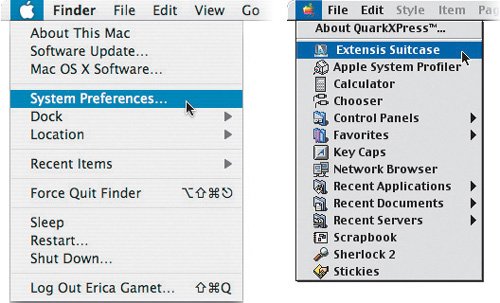How the Classic Environment Is Different from Mac OS 9
| Mac OS 9 is the culmination of years of operating-system development that started with the original Macintosh back in 1984. Once Apple introduced Mac OS X, support for Mac OS 9 was eventually dropped, and in 2003 Apple started phasing out Macs that were capable of booting into Mac OS 9. The Classic environment is a flavor of Mac OS 9 designed to run inside Mac OS X. One way to tell the difference between the terms Mac OS 9 and Classic: Someone using Mac OS 9 is using a Mac that is booted in Mac OS 9 instead of Mac OS X. On the other hand, if someone tells you he or she is using Classic, you know the person is really using Mac OS X and running an old Mac OS 9 application in the Classic environment (Figure 7.1). Figure 7.1. The Apple menu provides another way to tell whether an application is running in Tiger (left) or the Classic environment (right). Each menu holds very different items. Peripherals in the Classic EnvironmentUnless you are fairly new to the Mac, you probably remember using the Chooser to select printers and hoping your scanner and other peripherals would still work after each operating-system update. When you are using Classic applications, the Chooser is still in the rainbow Apple menu, and your printers work just like you remember. Scanners, on the other hand, can be a problem. If your scanner driver works at the software level, meaning it talks to the Classic environment when it wants to scan, you are fine. If your scanner driver works at the hardware level, meaning it bypasses the Classic environment and tries to talk directly to the hardware in your Mac, it won't work. From my experience, Canon and Epson scanners tend to work in the Classic environment, and Umax scanners don't. If you need to use a peripheral in the Classic environment, most manufacturers have Classic compatible drivers on their Web sites, so that's a good place to check. Fewer and fewer manufacturers are supporting the Classic environment and Mac OS 9, so this may be a good time to evaluate why you are using a device or software that doesn't work in Mac OS X. If it's critical to continue using Mac OS 9specific products, consider holding on to an older Mac workstation that boots into Mac OS 9, because Apple's new Intel-based Macs aren't even capable of running the Classic environment. Designing projects on a MacBook Pro, for example, requires you to use Mac OS Xnative applications.
|
EAN: 2147483647
Pages: 107